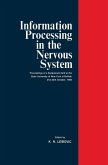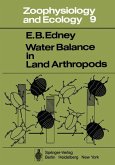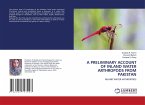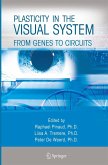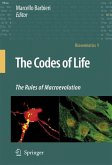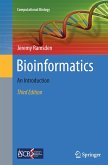Information Processing in the Visual Systems of Arthropods
Symposium Held at the Department of Zoology, University of Zurich, March 6-9, 1972
Herausgegeben von Wehner, Rüdiger
Information Processing in the Visual Systems of Arthropods
Symposium Held at the Department of Zoology, University of Zurich, March 6-9, 1972
Herausgegeben von Wehner, Rüdiger
- Broschiertes Buch
- Merkliste
- Auf die Merkliste
- Bewerten Bewerten
- Teilen
- Produkt teilen
- Produkterinnerung
- Produkterinnerung
It is now generally accepted for a variety of reasons - morphological as well as physiologica- that the visual systems of arthropods provide a suitable model for the study of information proces sing in neuronal networks. Unlike the neurophysiology of the visual pathway in the frog and the cat which is more than adequately documented, recent work on the compound eye and optical ganglia of spiders, crustaceans, and insects has scarcely been summarized. In order to fill this void so that others, especially vertebrate neurophysiologists may become familiar with the advan tages of these systems,…mehr
Andere Kunden interessierten sich auch für
![Information Processing in The Nervous System Information Processing in The Nervous System]() Information Processing in The Nervous System39,99 €
Information Processing in The Nervous System39,99 €![Water Balance in Land Arthropods Water Balance in Land Arthropods]() E. B. EdneyWater Balance in Land Arthropods77,99 €
E. B. EdneyWater Balance in Land Arthropods77,99 €![A PRELIMINARY ACCOUNT OF INLAND WATER ARTHROPODS FROM PAKISTAN A PRELIMINARY ACCOUNT OF INLAND WATER ARTHROPODS FROM PAKISTAN]() Quddusi B. KazmiA PRELIMINARY ACCOUNT OF INLAND WATER ARTHROPODS FROM PAKISTAN26,99 €
Quddusi B. KazmiA PRELIMINARY ACCOUNT OF INLAND WATER ARTHROPODS FROM PAKISTAN26,99 €![Plasticity in the Visual System Plasticity in the Visual System]() Plasticity in the Visual System112,99 €
Plasticity in the Visual System112,99 €![The Codes of Life The Codes of Life]() The Codes of Life186,99 €
The Codes of Life186,99 €![GenBank GenBank]() GenBank19,99 €
GenBank19,99 €![Bioinformatics Bioinformatics]() Jeremy RamsdenBioinformatics43,99 €
Jeremy RamsdenBioinformatics43,99 €-
-
-
It is now generally accepted for a variety of reasons - morphological as well as physiologica- that the visual systems of arthropods provide a suitable model for the study of information proces sing in neuronal networks. Unlike the neurophysiology of the visual pathway in the frog and the cat which is more than adequately documented, recent work on the compound eye and optical ganglia of spiders, crustaceans, and insects has scarcely been summarized. In order to fill this void so that others, especially vertebrate neurophysiologists may become familiar with the advan tages of these systems, our group at Zurich University organized here in March 1972, a European meeting to discuss the anatomical. ! neurophysiological and behavioral knowledge on the compound eye and the visual. pathway of arthropods. Systems analysis was regarded as the main theme of the conference, but systems analysis of a network of neurons cannot be done as a mere "black-box" maneuver. The conference therefore tried to reconcile neurophysiology and behavioral analysis in order to make predictions about a necessary and sufficient neural structure. The "wiring dia grams" of such a structure might then be confirmed histologically. Hence the aim of the conferen ce was not to deal only with the structure and function of the compound eye - i. e.
Produktdetails
- Produktdetails
- Verlag: Springer / Springer Berlin Heidelberg / Springer, Berlin
- Artikelnr. des Verlages: 978-3-540-06020-8
- 1972.
- Seitenzahl: 352
- Erscheinungstermin: 14. Dezember 1972
- Englisch
- Abmessung: 244mm x 170mm x 20mm
- Gewicht: 710g
- ISBN-13: 9783540060208
- ISBN-10: 3540060200
- Artikelnr.: 26490303
- Herstellerkennzeichnung
- Springer-Verlag GmbH
- Tiergartenstr. 17
- 69121 Heidelberg
- ProductSafety@springernature.com
- Verlag: Springer / Springer Berlin Heidelberg / Springer, Berlin
- Artikelnr. des Verlages: 978-3-540-06020-8
- 1972.
- Seitenzahl: 352
- Erscheinungstermin: 14. Dezember 1972
- Englisch
- Abmessung: 244mm x 170mm x 20mm
- Gewicht: 710g
- ISBN-13: 9783540060208
- ISBN-10: 3540060200
- Artikelnr.: 26490303
- Herstellerkennzeichnung
- Springer-Verlag GmbH
- Tiergartenstr. 17
- 69121 Heidelberg
- ProductSafety@springernature.com
Opening Remarks.- I. Anatomy of the Visual System.- 1. Periodic Structures and Structural Gradients in the Visual Ganglia of the Fly.- 2. Synaptology of the Lamina ganglionaris in the Fly.- 3. Some Interrelationships between the First and Second Synaptic Regions of the Fly's (Musca domestica) Visual System.- 4. Columns and Layers in the Second Synaptic Region of the Fly's Visual System: The Case for Two Superimposed Neuronal Archicetures.- 5. The Fine Structure of the Compound Eye of Formica polyctena - Functional Morphology of a Hymenopterean Eye.- 6. Measurements on the Arrangement of Ommatidial Structures in the Retina of Cataglyphis bicolor (Formicidae, Hymenoptera).- 7. The Ultrastructure of the Photosensible Elements in the Eyes of Collembola and Their Orientation (Insecta).- II. Optics of the Compound Eye.- 1. The Visual System of Musca: Studies on Optics, Structure and Function.- 2. Pupil and Pseudopupil in the Compound Eye of Drosophila.- 3. Directional Intensity Distribution in Single Ommatidia of the Honeybee, Apis mellifera.- 4. Pigment Migration and the Pupil of the Dioptric Apparatud in Superposition Eyes.- 5. Eye Movements in the Housefly Musca domestica.- III. Biochemistry of Visual Pigments.- 1. Photoreconversion of Invertebrate Visual Pigments.- 2. Metarhodopsin in Single Rhabdomeres of the Fly, Calliphora erythrocephala.- IV. Intensity - Dependent Reactions.- 1. The Discrimination of Light Intensities in the Honey Bee.- 2. Photopositive Reactions of Honey Bees to Circular Areas of Varying Sizes and Light Intensities.- 3. Screening Pigment and Visual Field of Single Retinula Cells of Calliphora.- 4. Orcadian Sensitivity Changes in the Median Eyes of the North African Scorpion, Androctonus australis.- 5. Dark Activation of the Stationary Flightof the Fruitfly Drosophila.- V. Wavelength - Dependent Reactions.- 1. Electrophysiological Studies on the Eyes of Diptera, Mecoptera and Hymenoptera.- 2. Wavelength-specific Behavioral Reactions in Drosophila melanogaster.- 3. A Preliminary Report on the Analysis of the Optomotor System of the Bee - Behavioral Studies with Spectral Lights.- 4. A Preliminary Report on the Analysis of the Optomotor System of the Honey Bee - Single Unit Recordings during Stimulation with Spectral Lights.- 5. Spectral Sensitivity and Wavelength Discrimination in Cataglyphis bicolor (Formicidae).- 6. ERG of Formica polyctena and Selective Adaptation.- VI. Pattern Recognition.- 1. Pattern Modulation and Pattern Detection in the Visual System of Hymenoptera.- 2. Experiments on Pattern Discrimination in Honey Bees.- 3. A Qualitative Model for Pattern Discrimination in the Honey Bee.- 4. The Ability of Honey Bees to Generalise Visual Stimuli.- 5. First Steps in a Behavioral Analysis of Pattern Discrimination in Diptera.- 6. Intraaxonal Visual Responses from Visual Cells and Second-order Neurons of an Insect Retina.- 7. Ethometrical Investigations into the Spatial Interaction within the Visual System of Velia caprai (Hemiptera, Heteroptera).- 8. Mechanisms of Orientation and Pattern Recognition.- 9. Observations on the Visual Reactions of Collembola.- VII. Visual Control of Orientation Patterns.- 1. Processing of Clues from the Moving Environment in the Drosophila Navigation System.- 2. Behavioral Diagnostics; a Way to Analyse Visual Mutants of Drosophila.- 3. Resultant Positioning between Optical and Kinesthetic Orientation in the Spider Agelena labyrinthica clerck.- 4. Idiothetic Course Control and Visual Orientation.- 5. The Relation of Astromenotactic and Anemomenotactic OrientationMechanisms in Desert Ants, Cataglyphis bicolor (Formicidae, Hymenoptera).- 6. The Significance of Different Eye Regions for Astromenotactic Orientation in Cataglyphis bicolor (Formicidae, Hymenoptera).- 7. The Visual Orientation of Desert Ants, Cataglyphis bicolor, by Means of Terrestrial Clues.- 8. Distance Measuring as Influenced by Terrestrial Clues in Cataglyphis bicolor (Formicidae, Hymenoptera).- VIII. Storage of Visual Information.- 1. The Time-Dependent Storing of Optical Information in the Honey Bee.- 2. Learning Experiments on the Use of Side - Specific Information in the Olfactory and Visual System in the Honey Bee (Apis mellifica).- IX. Methods of Quantifying Behavioral Data.- 1. The Relationship between Difference in Stimuli and Choice Frequency in Training Experiments with the Honey Bee.
Opening Remarks.- I. Anatomy of the Visual System.- 1. Periodic Structures and Structural Gradients in the Visual Ganglia of the Fly.- 2. Synaptology of the Lamina ganglionaris in the Fly.- 3. Some Interrelationships between the First and Second Synaptic Regions of the Fly's (Musca domestica) Visual System.- 4. Columns and Layers in the Second Synaptic Region of the Fly's Visual System: The Case for Two Superimposed Neuronal Archicetures.- 5. The Fine Structure of the Compound Eye of Formica polyctena - Functional Morphology of a Hymenopterean Eye.- 6. Measurements on the Arrangement of Ommatidial Structures in the Retina of Cataglyphis bicolor (Formicidae, Hymenoptera).- 7. The Ultrastructure of the Photosensible Elements in the Eyes of Collembola and Their Orientation (Insecta).- II. Optics of the Compound Eye.- 1. The Visual System of Musca: Studies on Optics, Structure and Function.- 2. Pupil and Pseudopupil in the Compound Eye of Drosophila.- 3. Directional Intensity Distribution in Single Ommatidia of the Honeybee, Apis mellifera.- 4. Pigment Migration and the Pupil of the Dioptric Apparatud in Superposition Eyes.- 5. Eye Movements in the Housefly Musca domestica.- III. Biochemistry of Visual Pigments.- 1. Photoreconversion of Invertebrate Visual Pigments.- 2. Metarhodopsin in Single Rhabdomeres of the Fly, Calliphora erythrocephala.- IV. Intensity - Dependent Reactions.- 1. The Discrimination of Light Intensities in the Honey Bee.- 2. Photopositive Reactions of Honey Bees to Circular Areas of Varying Sizes and Light Intensities.- 3. Screening Pigment and Visual Field of Single Retinula Cells of Calliphora.- 4. Orcadian Sensitivity Changes in the Median Eyes of the North African Scorpion, Androctonus australis.- 5. Dark Activation of the Stationary Flightof the Fruitfly Drosophila.- V. Wavelength - Dependent Reactions.- 1. Electrophysiological Studies on the Eyes of Diptera, Mecoptera and Hymenoptera.- 2. Wavelength-specific Behavioral Reactions in Drosophila melanogaster.- 3. A Preliminary Report on the Analysis of the Optomotor System of the Bee - Behavioral Studies with Spectral Lights.- 4. A Preliminary Report on the Analysis of the Optomotor System of the Honey Bee - Single Unit Recordings during Stimulation with Spectral Lights.- 5. Spectral Sensitivity and Wavelength Discrimination in Cataglyphis bicolor (Formicidae).- 6. ERG of Formica polyctena and Selective Adaptation.- VI. Pattern Recognition.- 1. Pattern Modulation and Pattern Detection in the Visual System of Hymenoptera.- 2. Experiments on Pattern Discrimination in Honey Bees.- 3. A Qualitative Model for Pattern Discrimination in the Honey Bee.- 4. The Ability of Honey Bees to Generalise Visual Stimuli.- 5. First Steps in a Behavioral Analysis of Pattern Discrimination in Diptera.- 6. Intraaxonal Visual Responses from Visual Cells and Second-order Neurons of an Insect Retina.- 7. Ethometrical Investigations into the Spatial Interaction within the Visual System of Velia caprai (Hemiptera, Heteroptera).- 8. Mechanisms of Orientation and Pattern Recognition.- 9. Observations on the Visual Reactions of Collembola.- VII. Visual Control of Orientation Patterns.- 1. Processing of Clues from the Moving Environment in the Drosophila Navigation System.- 2. Behavioral Diagnostics; a Way to Analyse Visual Mutants of Drosophila.- 3. Resultant Positioning between Optical and Kinesthetic Orientation in the Spider Agelena labyrinthica clerck.- 4. Idiothetic Course Control and Visual Orientation.- 5. The Relation of Astromenotactic and Anemomenotactic OrientationMechanisms in Desert Ants, Cataglyphis bicolor (Formicidae, Hymenoptera).- 6. The Significance of Different Eye Regions for Astromenotactic Orientation in Cataglyphis bicolor (Formicidae, Hymenoptera).- 7. The Visual Orientation of Desert Ants, Cataglyphis bicolor, by Means of Terrestrial Clues.- 8. Distance Measuring as Influenced by Terrestrial Clues in Cataglyphis bicolor (Formicidae, Hymenoptera).- VIII. Storage of Visual Information.- 1. The Time-Dependent Storing of Optical Information in the Honey Bee.- 2. Learning Experiments on the Use of Side - Specific Information in the Olfactory and Visual System in the Honey Bee (Apis mellifica).- IX. Methods of Quantifying Behavioral Data.- 1. The Relationship between Difference in Stimuli and Choice Frequency in Training Experiments with the Honey Bee.



